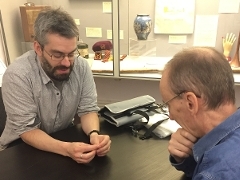Do you really know what you found?
A sneak peek into Simon Maslin's role as the new Surrey Finds Liaison Officer.

What it's like to identify Surrey's archaeological finds

People find all sorts of interesting ancient artefacts in Surrey, whether by searching using metal detectors or by accident while gardening or walking in the countryside. My role is to work for Surrey County Council on behalf of the Portable Antiquities Scheme and the British Museum to help people in Surrey identify and record these objects if they are pre 17th century or otherwise locally significant. Sometimes people can even find valuable items made of precious metal, or groups of coins and other artefacts which all fall under the legal definition of "Treasure" and I can help these finders to negotiate the legal requirement to report these items to the County Coroner.

I've been involved in archaeology for about twenty five years, from my first digs with the Surrey Archaeological Society, to my most recent work during the last ten years as a researcher and academic at the University of Reading, where I was involved with a range of projects on sites spanning the Mesolithic to the early Medieval periods, as well as undertaking a PhD studying an Anglo-Saxon royal site in Kent. Along the way, I've worked in all sorts of different archaeological roles from teaching to fieldwork and laboratory analysis. This has given me a great deal of understanding about the different kinds of things that people have made in the past and how they were used.
In my role as Finds Liaison Officer for Surrey, I get to use this archaeological experience to identify the often bewildering diversity of objects that people show me. Sometimes these objects are easy to classify and well catalogued - but sometimes they can be enigmatic and poorly understood. Identifying them requires practical experience of a huge range of materials and artefacts, from flint tools, to Roman coins to Tudor hairpins. It also requires the ability to quickly assess what something is made of and how old it is, in order to separate things which are ancient or might even made of precious metal from a collection of random objects found in a field, most of which may be modern.
My job enables me to see some absolutely fascinating items - from the mundane, such as Tudor buttons and Medieval buckles, to the truly extraordinary, such as previously unknown types of Anglo-Saxon and Iron Age coins which have never been seen before. My very favourite items are probably those that help tell a story about the areas we live in, especially medieval seals, rings and tokens which may have names inscribed on them and which we can relate to individuals named in historical records.
Through the process of researching and recording these finds, I'm able, together with my colleagues around the country, to add to our national database, which allows researchers and interested members of the public to better understand them. Through meeting and talking to finders, I also hope to be able to promote awareness of the law concerning Treasure and best practice such as the Countryside Code and the Code of Practice for Responsible Metal Detecting. Working with my colleagues in Surrey County Council's Historic Environment Record I'm able to ensure that all finds made locally are recorded as a part of the heritage records for the local area.
If you've found anything that you would like identifying, or which you suspect could be worth recording, please get in touch, especially if you've found anything that you think, might be old and made of precious metal, as this may need to be reported by law.
I'm available by appointment at the Surrey History Centre in Woking on Wednesdays and at Guildford House Gallery on the second Saturday of each month. I am also contactable by email most of the time (simon.maslin@surreycc.gov.uk) to give advice or help with identifications.
